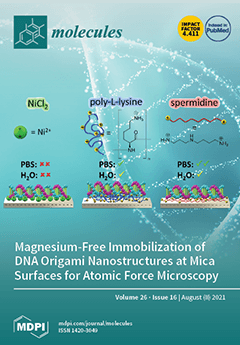This article presents the results of a study of electrochemical transformations in aqueous and aprotic media of 5-methyl-6-nitro-7-oxo-4,7-dihydro-1,2,4-triazolo[1,5-a]pyrimidinide l-arginine monohydrate (
1a, Triazid) obtained by electrochemical methods and ESR spectroscopy. The effect of pH on the current and the reduction potential of
[...] Read more.
This article presents the results of a study of electrochemical transformations in aqueous and aprotic media of 5-methyl-6-nitro-7-oxo-4,7-dihydro-1,2,4-triazolo[1,5-a]pyrimidinide l-arginine monohydrate (
1a, Triazid) obtained by electrochemical methods and ESR spectroscopy. The effect of pH on the current and the reduction potential of
1a in an aqueous Britton–Robinson buffer solution was studied. It was found that 1a is irreversibly reduced in aqueous acidic media on a glassy carbon electrode in one stage with the participation of six electrons and the formation of 5-methyl-6-amino-7-oxo-1,2,4-triazolo[1,5-a]pyrimidin. The electroreduction of
1a in DMF on a background of tetrabutylammonium salts proceeds in two stages, controlled by the kinetics of second-order reactions. In the first stage, the reduction of
1a is accompanied by protonation by the initial compound of the basic intermediate products formed in the electrode reaction (self-protonation mechanism). The second quasi-reversible stage of the electroreduction
1a corresponds to the formation of a dianion radical upon the reduction of the heterocyclic anion 5-methyl-6-nitro-7-oxo-4,7-dihydro-1,2,4-triazolo[1,5-a]pyrimidin, which is formed upon the potentials of the first peak. The ESR spectrum of the radical dianion was recorded upon electroreduction of Triazid in the presence of Bu
4NOH. The effect of the formation of ion pairs on the reversibility of the second peak of the
1a transformation is shown. A change in the rate and regioselectivity of the protonation of the dianion radical in the presence of Na
+ and Li
+ ions is assumed. The results of studying the electroreduction of
1a by ESR spectroscopy with a TEMPO trap make it possible to assume the simultaneous formation of both a nitroxyl radical and a radical with the spin density localized on the nitrogen at the 4 position of the six-membered ring.
Full article






